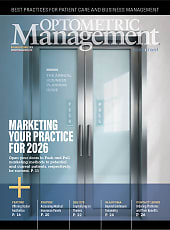
There are many beliefs and ideas surrounding corporate optometry.
Many are myths that have been around for a long time but hold little truth. On these three pages, we aim to set things straight and debunk those myths.
What are some of the common misconceptions in the industry? Some think that corporate optometrists are not allowed to practice medical eye care, do not provide the same quality of care as private clinics, don’t have work-life balance, and that their patients come to the office because of the corporate brand, not the O.D.
The fact is that there are a lot of great corporate O.D. offices that provide the highest standard of care. In fact, this mode of practice allows you to see a wide range of patients and sharpen your clinical skills.
In addition, corporate optometrists see a lot of diverse conditions. The increase in patient base leads to a full schedule—and more chances to see medical conditions such as diabetes, glaucoma, and ARMD walk through the door.
I’m able to treat anything that I choose to in my office setting; I have embraced the medical model, as have a lot of other corporate O.D.s, with advanced technology in our offices.
Read on to see the other key myths about corporate optometry debunked.
MYTH #1:
Corporate O.D.s Don’t Practice Medical Eye Care
Corporate practices see a wide range of patients. Optometry is evolving, and corporate O.D.s are at the front line for providing medical eye care to many of these patients. In addition, many offices have OCTs, visual fields, and other technology to provide advanced care to patients.

MICHAEL SIROTT, O.D.,
a sublease optometrist at Walmart in Omak, WA

MYTH #2:
Lower Quality of Care vs. Private Clinics
We are all optometrists with the same degrees. The four walls that surround us do not define our quality of care.
Our offices are equipped with all the equipment necessary to provide the highest standard of care to our patients. Many times, based on the practice volume, corporate optometry offices may have even more technology to provide.

ASHLEY HARBAUGH, O.D.,
an employed optometrist at Walmart in Lancaster, PA

MYTH #3:
Corporate O.D.s Have No Work-Life Balance
Many corporate O.D.s are able to balance the patient volume and have time for a family. There will be peak seasons in optometry that will be busier, but planning accordingly can help O.D.s find that work-life balance they are looking for.

ASMA ALSALAMEH, O.D.,
a sublease optometrist at Visionworks in Lake Jackson, TX

MYTH #4:
Patients Come to the Office Only Because of the Corporate Brand
Many corporate O.D.s have a loyal practice base and patients who will wait to see their eye doctor even though there is a fill-in optometrist at times. Corporate O.D.s have the ability to spend time with their patients—and build their own brand.
The sublease O.D. is a business owner just like the private practice O.D., but corporate O.D.s do have the benefit of a big corporate optical marketing budget that can attract new patients. In the end, however, it’s up to the corporate O.D. to retain those patients. Thus, personal branding within a corporate setting is important for patient retention.

CARLA GAVILANES, O.D.,
two successful sublease locations in Austin, TX

MYTH #5:
Corporate Optometry Only Focuses on Selling Eyewear
One of the big initiatives in corporate optometry is being able to retain patients and have them return year after year—and refer their family and friends. One way to do that is through the optometrist’s office.
Many corporate optical chains have invested in new lanes and advanced equipment to help differentiate themselves from other offices and online competitors. Optical managers partner with the O.D. to create an experience for the patient that goes far beyond selling glasses. COT!

FALLON PATEL, O.D.,
a sublease holder at LensCrafters in Oakville, Ontario, Canada

MORE ONLINE
Find out more from the “Corporate Optometry on Facebook” group hashtag #corporateoptometrymyths.



